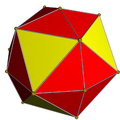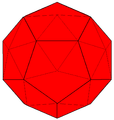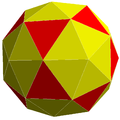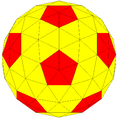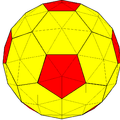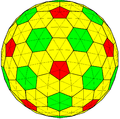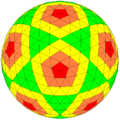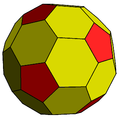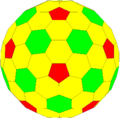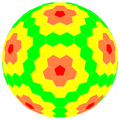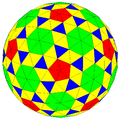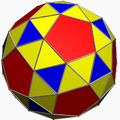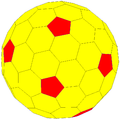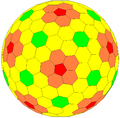- Conway polyhedron notation
-
Conway polyhedron notation is used to describe polyhedra based on a seed polyhedron modified by various operations.
The seed polyhedra are the Platonic solids, represented by their first letter of their name (T,O,C,I,D); the prisms (Pn), antiprisms (An) and pyramids (Yn). Any convex polyhedron can serve as a seed, as long as the operations can be executed on it.
John Conway extended the idea of using operators, like truncation defined by Kepler, to build related polyhedra of the same symmetry. His descriptive operators can generate all the Archimedean solids and Catalan solids from regular seeds. Applied in a series, these operators allow many higher order polyhedra to be generated.
Contents
Operations on polyhedra
Elements are given from the seed (v,e,f) to the new forms, assuming seed is a convex polyhedron: (a topological sphere, Euler characteristic=2)
Operator Name Alternate
constructionvertices edges faces Description Seed v e f Seed form r Reflect
(Hart)v e f Mirror image for chiral forms d dual f e v dual of the seed polyhedron - each vertex creates a new face a ambo e 2e 2+e The edges are new vertices, while old vertices disappear. (rectify) j join da e+2 2e e The seed is augmented with pyramids at a height high enough so that 2 coplanar triangles from 2 different pyramids share an edge. t truncate dkd 2e 3e e+2 truncate all vertices. -- -- dk 2e 3e e+2 Dual of kis, (bitruncation) -- -- kd e+2 3e 2e Kis of dual k kis dtd e+2 3e 2e raises a pyramid on each face. c chamfer e+v 4e 2e+f New hexagonal faces are added in place of edges. - - dc 2e+f 4e e+v e expand aa 2e 4e 2e+2 Each vertex creates a new face and each edge creates a new quadrilateral. (cantellate) o ortho de 2e+2 4e 2e Each n-gon faces are divided into n quadrilaterals. p propellor
(Hart)v+2e 4e e+f A face rotation that creates quadrilaterals at vertices (self-dual) - - dp e+f 4e v+2e s snub dg 2e 5e 3e+2 "expand and twist" - each vertex creates a new face and each edge creates two new triangles g gyro ds 3e+2 5e 2e Each n-gon face is divided into n pentagons. b bevel ta 4e 6e 2e+2 New faces are added in place of edges and vertices, Omnitruncation (Known as cantitruncation in higher polytopes). m meta db & kj 2e+2 6e 4e n-gon faces are divided into 2n triangles Special forms
- The kis operator has a variation, kn, which only adds pyramids to n-sided faces.
- The truncate operator has a variation, tn, which only truncates order-n vertices.
The operators are applied like functions from right to left. For example:
- the dual of a tetrahedron is dT;
- the truncation of a cube is t3C or tC;
- the truncation of a Cuboctahedron is t4aC or taC.
All operations are symmetry-preserving except twisting ones like s and g which lose reflection symmetry.
Examples
The cube can generate all the convex Octahedral symmetry uniform polyhedra. The first row generates the Archimedean solids and the second row the Catalan solids, the second row forms being duals of the first. Comparing each new polyhedron with the cube, each operation can be visually understood. (Two polyhedron forms don't have single operator names given by Conway.)
Cube
"seed"ambo
(rectify)truncate bitruncate expand
(cantellate)bevel
(omnitruncate)snub 
C
aC = djC
tC = dkdC
tdC = dkC
eC = aaC = doC
bC = taC = dmC = dkjC
sC = dgCdual join kis
(vertex-bisect)ortho
(edge-bisect)meta
(full-bisect)gyro 
dC
jC = daC
kdC = dtC
kC = dtdC
oC = deC = daaC
mC = dbC = kjC
gC = dsCGenerating regular seeds
All of the five regular polyhedra can be generated from prismatic generators with zero to two operators:
- Triangular pyramid: Y3 (A tetrahedron is a special pyramid)
- T = Y3
- O = aY3 (Rectified tetrahedron)
- C = daY3 (dual to rectified tetrahedron)
- I = sY3 (snub tetrahedron)
- D = dsY3 (dual to snub tetrahedron)
- Triangular antiprism: A3 (An octahedron is a special antiprism)
- O = A3
- C = dA3
- Square prism: P4 (A cube is a special prism)
- C = P4
- Pentagonal antiprism: A5
- I = k5A5 (A special gyroelongated dipyramid)
- D = t5dA5 (A special truncated trapezohedron)
Extensions to Conway's symbols
The above operations allow all of the semiregular polyhedrons and Catalan solids to be generated from regular polyhedrons. Combined many higher operations can be made, but many interesting higher order polyhedra require new operators to be constructed.
For example, geometric artist George W. Hart created an operation he called a propellor, and another reflect to create mirror images of the rotated forms.
- p - "propellor" (A rotation operator that creates quadrilaterals at the vertices). This operation is self-dual: dpX=pdX.
- r - "reflect" - makes the mirror image of the seed; it has no effect unless the seed was made with s or p.
Geometric coordinates of derived forms
In general the seed polyhedron can be considered a tiling of a surface since the operators represent topological operations so the exact geometric positions of the vertices of the derived forms are not defined in general. A convex regular polyhedron seed can be considered a tiling on a sphere, and so the derived polyhedron can equally be assumed to be positioned on the surface of a sphere. Similar a regular tiling on a plane, such as a hexagonal tiling can be a seed tiling for derived tilings. Nonconvex polyhedra can become seeds if a related topological surface is defined to constrain the positions of the vertices. For example torus-shaped polyhedra can derive other polyhedra with point on the same torus surface.
Example: A dodecahedron seed as a spherical tiling 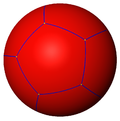
D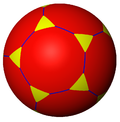
tD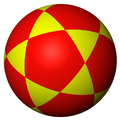
aD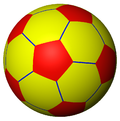
tdD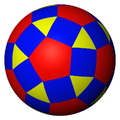
eD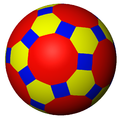
teD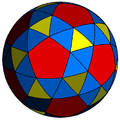
sD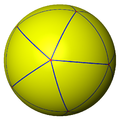
dD
dteDExample: An Euclidean hexagonal tiling seed (H) 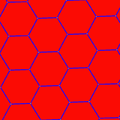
H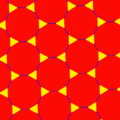
tH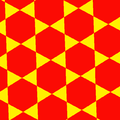
aH
tdH = H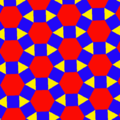
eH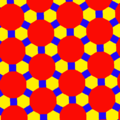
teH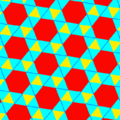
sH
dH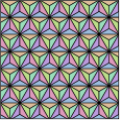
dtH
daH
dtdH = dH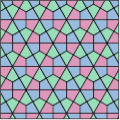
deH
dteH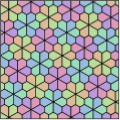
dsHExample: A transparent Tetrahedron seed (T) 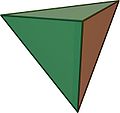
T
tT
aT
tdT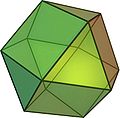
eT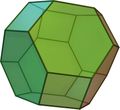
bT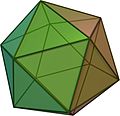
sT
dT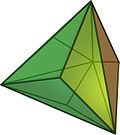
dtT
jT
kT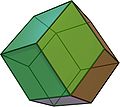
oT
mT
gTExample: A hyperbolic heptagonal tiling seed {7,3}
"seed"truncate ambo
(rectify)bitruncate expand
(cantellate)bevel
(omnitruncate)snub 
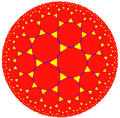

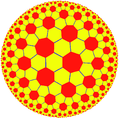
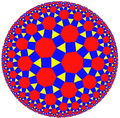
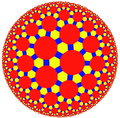
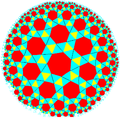
dual join kis
(vertex-bisect)ortho
(edge-bisect)meta
(full-bisect)gyro 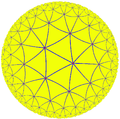
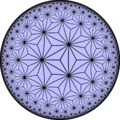

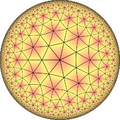
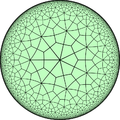

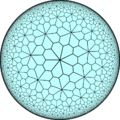
Other polyhedra
Iterating operators on simple forms can produce progressively larger polyhedra, maintaining the fundamental symmetry of the seed element. The vertices are assumed to be on the same spherical radius. Some generated forms can exist as spherical tilings, but fail to produce polyhedra with planar faces.
Tetrahedral symmetry
-
Truncated triakis tetrahedron
"t6dtT"
Octahedral symmetry
-
Truncated rhombic dodecahedron
"t4daC"
Icosahedral symmetry
Rhombic:
-
Rhombic enneacontahedron
"dakD"
Triangular:
Dual triangular:
-
Truncated icosahedron
"dkD" -
Truncated rhombic triacontahedron
"t5daD"
"cD"
Triangular chiral:
Dual triangular chiral:
See also
- Uniform polyhedra
- Computer graphics algorithms:
- Doo–Sabin subdivision surface - expand operator
- Catmull–Clark subdivision surface - ortho operator
References
- George W. Hart, Sculpture based on Propellorized Polyhedra, Proceedings of MOSAIC 2000, Seattle, WA, August, 2000, pp. 61-70 [1]
- John H. Conway, Heidi Burgiel, Chaim Goodman-Strass, The Symmetries of Things 2008, ISBN 978-1-56881-220-5
- Chapter 21: Naming the Archimedean and Catalan polyhedra and Tilings
External links and references
- George Hart's Conway interpreter: generates polyhedra in VRML, taking Conway notation as input
- polyHédronisme: generates polyhedra in HTML5 canvas, taking Conway notation as input
- Weisstein, Eric W., "Conway Polyhedron Notation" from MathWorld.
- John Conway's notation
- Weisstein, Eric W., "Truncation" from MathWorld. (truncate)
- Weisstein, Eric W., "Rectification" from MathWorld. (ambo)
- Weisstein, Eric W., "Cumulation or Apiculation" from MathWorld. (kis)
- Conway operators, PolyGloss, Wendy Krieger
- Derived Solids
Categories:- Elementary geometry
- Polyhedra
- Mathematical notation
Wikimedia Foundation. 2010.




